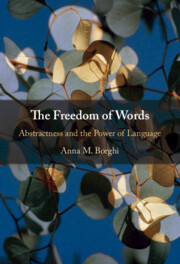Book contents
- The Freedom of Words
- The Freedom of Words
- Copyright page
- Dedication
- Contents
- Figures
- Acknowledgments
- Introduction
- Part I Language and Its Power
- Part II Abstractness and Language
- Chapter 5 Different Varieties of Abstract Concepts
- Chapter 6 Abstractness and Language as a Physical Tool
- Chapter 7 Abstractness and Language as an Inner Tool
- Chapter 8 Abstractness and Language as a Social Tool
- Chapter 9 Conclusion
- Index
- References
Chapter 5 - Different Varieties of Abstract Concepts
from Part II - Abstractness and Language
Published online by Cambridge University Press: 20 July 2023
- The Freedom of Words
- The Freedom of Words
- Copyright page
- Dedication
- Contents
- Figures
- Acknowledgments
- Introduction
- Part I Language and Its Power
- Part II Abstractness and Language
- Chapter 5 Different Varieties of Abstract Concepts
- Chapter 6 Abstractness and Language as a Physical Tool
- Chapter 7 Abstractness and Language as an Inner Tool
- Chapter 8 Abstractness and Language as a Social Tool
- Chapter 9 Conclusion
- Index
- References
Summary
Chapter 5 is the first chapter of the second part of the book and focuses on abstract concepts – more generally, on abstractness. I first define abstract concepts and illustrate their main characteristics, comparing them with concrete ones. I contend that there is no major opposition between concrete and abstract concepts and that many concepts have both abstract and concrete components. In addition, different varieties of abstract concepts exist. Thus, the different kinds of concrete and abstract concepts can be conceived of as points in a multidimensional space, defined by various features and dimensions. I then focus on the different subkinds of abstract concepts, including emotions and mental states, numerical and spatiotemporal concepts, self and social concepts, and spiritual and philosophical concepts. Finally, I outline the central tenets of the Words As social Tools (WAT) theory on abstractness. According to the WAT view, abstract concepts evoke perception and action but especially activate inner bodily experiences, including interoceptive, emotional, and metacognitive ones. Crucially, the WAT view ascribes a unique role to language and social interaction for abstract concept acquisition and use. Finally, it underscores the flexible and context-dependent character of abstract concepts.
Keywords
- Type
- Chapter
- Information
- The Freedom of WordsAbstractness and the Power of Language, pp. 153 - 181Publisher: Cambridge University PressPrint publication year: 2023

